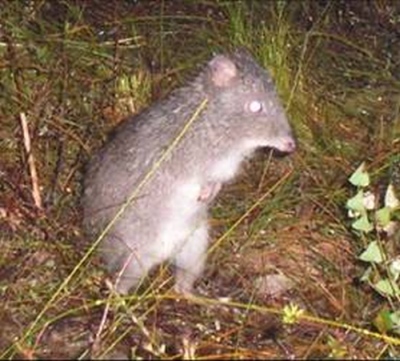Long-nosed Potoroo
Long-nosed PotorooPotorous tridactylus trisulcatus | |
|---|---|
| Kingdom: | Animalia |
| Phylum: | Chordata |
| Class: | Mammalia |
| Subclass: | Marsupiala |
| Order: | Diprotodontia |
| Family: | Potoroidae |
| Status | |
| Australia: | Vulnerable (EPBC Act listed) |
| Victoria: | Vulnerable (FFG Threatened List 2025) |
| FFG: | Listed: Action statement No. 254 (pdf) |
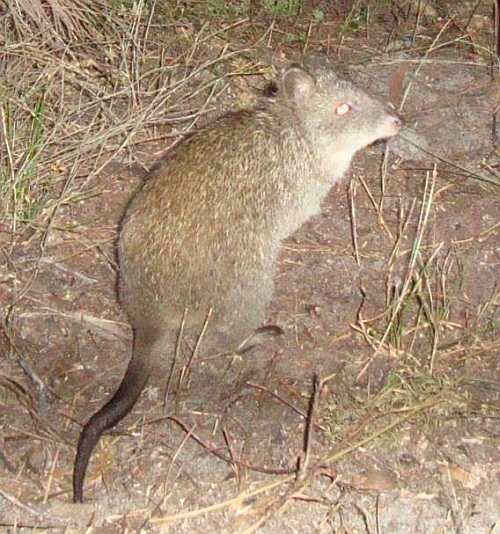
Long-nosed Potoroo Image: Mt Rothwell Biodiversity Information Centre
The Long-nosed Potoroo Potorous tridactylus is a medium sized hopping marsupial which is only found in South-eastern Australia, being confined to Tasmania and the coastal side of the Great Dividing Range on mainland Australia.
In 2012, three sub-species of Potorous tridactylus were identified (Frankham, Handasyde & Eldridge 2012);
- Potorous tridactylus trisulcatus (southern New South Wales and Victoria)
- Potorous tridactylus tridactylus (southern Queensland and northern New South Wales)
- Potorous tridactylus apicalis (Tasmania).
Males tend to be heavier and have a longer head than females (Frankham et al. 2011).
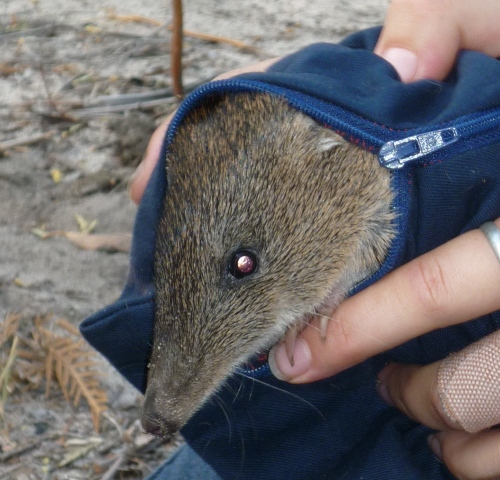
Distribution
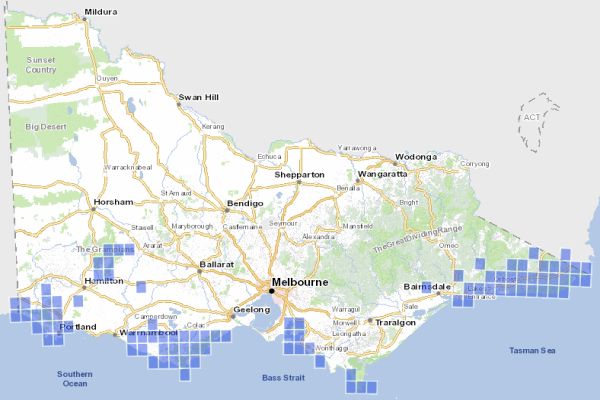
In Victoria, the Long-nosed Potoroo is concentrated at six main geographically isolated locations; East Gippsland, Wilsons Promontory, French Island, Otway Ranges, Lower Glenelg and Grampians (although there is now some doubt as to the viability of the population in the Grampians National Park).
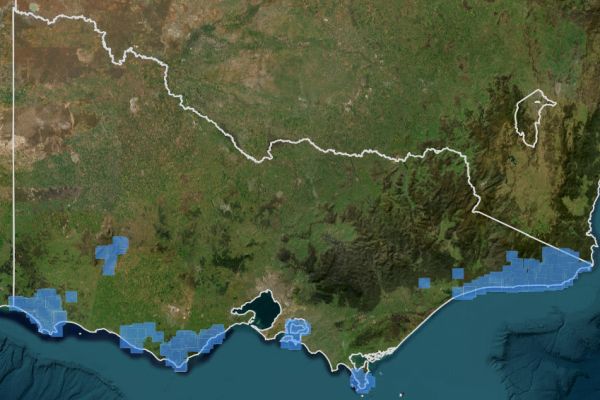
Status of species in the family Potoroidae known in Victoria
(FFG Threatened List 2025)
- Long-nosed Potoroo Potorous tridactylus (Vulnerable)
- Long-footed Potoroo Potorous longipes (Endangered)
- Rufous Bettong Aepyprymnus rufescens (Extinct)
- Eastern Bettong Bettongia gaimardi gaimardi (mainland subspecies) (Extinct)
- Brush-tailed Bettong Bettongia penicillata penicillata (eastern subspecies) (Extinct)
Such a severe depletion of the Potoroidae is an indication that members of this family are highly sensitive to changes in their environment brought about by disturbance to habitats and introduced predators (Seebeck 1995).
Ecology & Habitat
The Long-nosed Potoroo inhabits coastal heaths and eucalypt forests generally on nutrient-poor sandy or light soils where there is dense groundcover that provides microhabitat for shelter and protection from introduced predators. Whilst dense groundcover is an essential component of Long-nosed Potoroo habitat it does not seem to favour any discrete floristic group, it does however utilise a range of both dense and more open vegetation within a home range (Bennett 1987).
Species distribution models (SDMs) determined the highest probability of Long-nosed Potoroo occupancy is associated with EVC groups such as Heathlands (not well drained) and Heathlands (sandy/well drained). To a lesser extent, Riverine Grassy Woodlands or Forests (creek line and or swampy), Riparian Scrubs or Swampy Scrubs and Woodlands were also shown to provide higher habitat suitability than other EVC groupings. Modelling also suggested the Long-nosed Potoroo favours areas approximately 70 years post-burn. (Lupone et al. 2025).
Camera trap surveys carried at between 2021 to 2024 found that potoroos were more likely to inhabit areas close to watercourses, on lower, flat slopes in areas of higher productivity; and these characteristics readily represent the habitat found in riparian and heathland vegetation types. These high probability areas are seemingly situated within pockets of wet heath and adjoining riparian habitats along drainage lines that are associated with higher soil moisture and vegetation density. Potoroos are likely to have been able to maintain populations in these habitats as they contain denser vegetation structure which provides the species with elevated protection from invasive feral cats and red foxes (Lupone et al. 2025).
Feeding
The Long-nosed Potoroo is highly mycophagous (fungus feeding) and more sparsely vegetated areas may be used for foraging where they dig for sporocarps (fruiting bodies) of hypogeal (underground fruiting) fungi). They forage over a range of topographies (from ridge to gully) and aspects (sheltered and exposed) throughout the year. Their foraging patterns are largely influenced by the availability and changing fruit patterns of hypogeous fungi (Claridge et al. 1993, Tory et al.1997, Claridge et al.2000). In South-west Victoria near Naringal, it was found that hypogeal fungi comprised more than 70% of the diet, particularly during autumn/winter. Invertebrates and plant material were consumed more during spring/summer but hypogeal fungi still comprised at least 25% of the diet (Bennett 1987).
Potoroos have an enlarged forestomach which facilitates microbial fermentation and allows the uptake of nutrients from fungi (Claridge & Cork 1994). Studies in southeastern Australia have recorded up to 60 species of fungus being consumed (Bennett 1987, Claridge et al. 1993) major taxonomic divisions being Basidiomycetes (mushrooms), Ascomycetes (sac fungi) and Zygomycetes (molds).
In situations where forests are undisturbed it has been found that Long-nosed Potoroos consume a larger quantity and diversity of fungi than potoroos in a young regrowth forest indicating differences in the availability of that food resource. Studies to identify factors that influence the distribution, habitat and foraging areas of Potoroos indicate there is a distinct preference for habitats that have remained unburnt for 20 or more years (Claridge et al.2000).
Breeding
Under normal conditions the Long-nosed Potoroo lives for about 7 years; males are sexually reproductive before reaching their first year, females between one and two years. The adult female Long-nosed Potoroo produces about 2 to a maximum of 3 young per year (Bennett 1987). Females carry a single young in the pouch for about four months duration, they can be found with pouched young at anytime of the year as the reproductive cycle is continuous (Frankham et al. 2011).
Movement
Potoroos are generally considered to be nocturnal, although studies at Ralph Illage sanctuary in Victoria found evidence of diurnal activity where Potoroos were sighted crossing tracks and foraging in clearings throughout the day in a variety of weather conditions (Kirstin 2001). During the day, potoroos usually rest in shallow depressions or nests (squats), which can be located under tussocks, in thickets or among rocks and against logs. The home range area has been measured between 2.0 to 4.0 ha for male potoroos and around 1.4-to 2 ha for females (Bennett 1987, Seebeck 1995, Kirstin 2001). Studies by Kirstin (2001), found the male home range overlapped the ranges of 1-4 females, and ranges of females were overlapped by those of 2-3 males.
Long-nosed Potoroo, standing with large hind legs enabling a hopping motion. Image taken with remote camera. Source: Glenelg Ark.
Ecological benefits
The Long-nosed Potoroo is an important part of the forest/bushland ecology, particularly as their diet comprises a high proportion of hypogeous fungi with sporocarps that may enhance the re-establishment of mycorrhizal colonies in logged and/or burned forest sites through dispersal in faeces. The dispersal of mycorrhizal fungi may aid in the recovery of plants regenerating in eucalypt forests (Claridge et al. 1992). The digging mammals such as the Long-nosed Potoroo can also play an important role in mixing leaf litter with soils to aid the aeration of topsoil and breakdown of litter as well as providing substrate for microorganisms, improved water balance and mineral cycles, all which contribute to providing optimal sites for seed germination and seedling establishment (Martin 2003). Claridge et al.(1993) considered the role of the Long-nosed Potoroo to be such an integral part of the forest ecology that it is suggested the potential beneficial role it plays needs to be formally recognised in forest management plans.
Threats
Habitat loss
Major threats are associated with the clearing of bushland, loss of dense understory and fragmentation of habitats. The inclusion of dense understorey within the home range of the Long-nosed Potoroo is a determining factor for the presence of this species as it provides essential shelter and pockets of habitat diversity. Loss of habitat through frequent and extreme fire events or clearing of vegetation may also impact on the presence and diversity of hypogeal fungi which are a major food source.
Frequent fires are a major threat considering SDM modelling has suggested the Long-nosed Potoroo favours areas approximately 70 years post-burn. (Lupone et al. 2025).
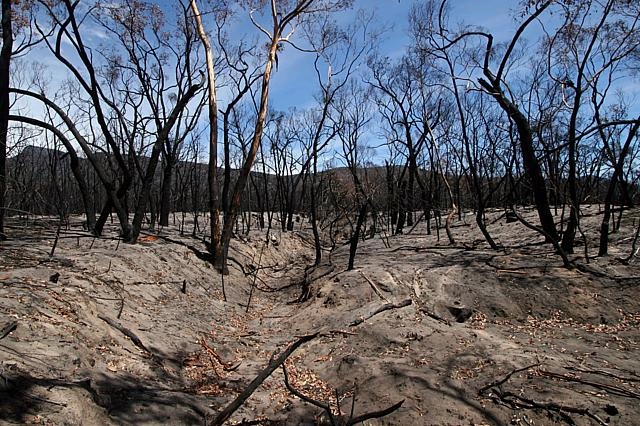
Typical scene of Long-nosed Potoroo habitat loss (wet heath and adjoining riparian habitats along drainage lines that are associated with higher soil moisture and vegetation density) after high intensity fire in Grampians.
Predators
The main predators to Long-nosed Potoroos are introduced animals such as the Feral Cat Felis catus and Red Fox Vulps vulps. Anecdotal observations by Claridge et al. (2000) suggest that where dense ground cover is reduced at a local scale, animals such as the potoroo suffer increased predation by feral predators.
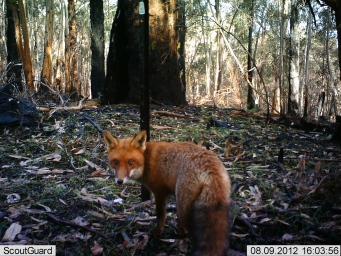
Fox at Long-nosed Potoroo survey site in Otway Ranges. Source: Saul Vermeeren
Fragmentation of populations
Habitat corridors such as roadside vegetation, streamside vegetation and bushland on farmland were recognised by Bennett (1987) as important areas for the movement and dispersal of Long-nosed Potoroos between patchy and fragmented habitats. Loss of connectivity between habitats results in populations being isolated and more vulnerable to impacts from habitat disturbance.
Fuel reduction burning
Studies on the distribution of the Long-nosed Potoroo by Claridge et al. (2000) indicate that Long-nosed Potoroos are more likely to be found in habitats unburned for 20 or more years. This may reflect the time it takes to establish key microhabitats for these species, both in terms of shelter as well as food resources. It is suggested that prescribed burning is being used too frequently in many cases to allow for the creation of suitable habitat for potoroos.
Conservation & Management
The conservation status of Long-nosed Potoroo was re-assessed from Endangered in 2013 (DSE 2013) to Vulnerable in 2020 as part of the Conservation Status Assessment Project – Victoria (DELWP 2020). It is currently listed as Vulnerable (FFG Threatened List 2025).
Implement survey and monitoring programs to obtain essential data on distribution and abundance of the Long-nosed Potoroo.
On-going fox control as part of Southern Ark, Glenelg Ark and Grampians Ark.
Identify important populations (i.e. large populations in intact habitat, edge of geographic range populations, genetically distinct populations and populations in atypical habitat)
Undertake research to improve understanding of habitat requirements and life history.
Improve public knowledge and understanding of ecological, social and economic issues related to the Long-nosed Potoroo and build community support for recovery.
Fuel reduction burning programs may require a closer review in circumstances where potoroos are known to occur to ensure that prescribed burning is carried out with adequate time intervals to allow recovery of habitat for populations of the Long-nosed Potoroo.
Grampians / Wimmera area
Grampians National Park
- Conduct surveys to better understand distribution & abundance.
- Continue implementation of the Grampians Ark predator control project.
Declining population
Surveys for the Long-nosed Potoroo were carried out at Gariwerd (Grampians National Park) using species distribution models (SDMs) to guide targeted camera trapping between 2021 to 2024 (Lupone et al. 2025). A total of 373 camera trapping points were surveyed across all years with an average distance of 630 m, and a minimum of 100 m between sites totalling 10,533 camera trap nights.
- 2021, potoroos detected at 6 of 154 sites (4 %).
- 2022, potoroos recorded at 2 of 16 sites (12.5 %)
- 2023 no detection at 8 known sites
- 2024, potoroos recorded at two of 195 sites (1 %)
In late December 2024 to March 2025 a major bushfire burnt most of the Grampians N.P., including Long-nosed Potoroo habitat identified in SDMs. Since the fires, despite focusing on known areas of occupancy and using 200 camera traps, no live potoroos have been detected in the park (J. White pers. comm. 2025).
Grampians fires
A sequence of major fires in the Grampians National Park have played a significant role in the suspected total loss of the Long-nosed Potoroo in the area.
A megafire in 2006, burnt roughly half the park landscape (∼85,000 ha), two subsequent large-scale wildfires in 2013 and 2014, burnt 35,000 and 55,000 ha respectively, primarily in areas unaffected by the 2006 wildfire. In total, these three wildfire events burnt approximately 90 % of the Gariwerd landscape (Lupone et al. 2025).
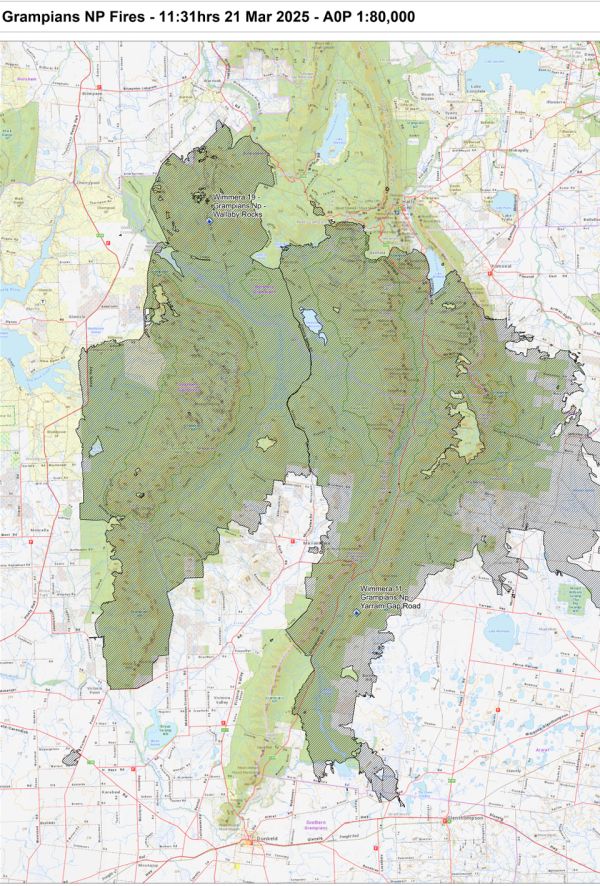
In late December 2024 to March 2025 a major bushfire burnt almost the entire Grampians N.P., including areas once known to be Long-nosed Potoroo habitat.Shaded area indicates extent of 2025 fires. Source: Business Victoria. pdf version.
Wimmera CMA area
On-going surveys in suitable habitat to determine the current extent of Long-nosed Potoroos in the Greater Grampians and Wimmera Bioregions.
In 2011 and 2012 surveys were undertaken in partnership with Parks Victoria targeting the eastern side of the Grampians bioregion including the Black Range State Reserve, Mokepilly Bushland Reserve, Jallukar Reserve and the eastern side of the Black Range State Park. These surveys included trapping and use of remote cameras. Other areas surveyed included Panrock Reservoir, Rowes Bushland Reserve, Jallukar Forest, Cherrypool State and Telangatuk East State Forest. On average 6 cameras were used over a 33 day period at each of the survey sites, which is the equivalent of 2,764 trap nights. In total fourteen areas consisting of a total 86 sites and covering approximately 1,050 ha was surveyed in the Greater Grampians and Wimmera Bioregions. No Long-nosed Potoroos were detected in any of the surveys.
Live trapping was also conducted during October 2011, April 2012 and May 2012 in the Grampians National Park at three different Greater Grampians Bioregions (Wartook, Wannon and Ming Ming Swamp), but with no Long-nosed Potoroo being detected.
A number of surveys have also been undertaken on private property in the Black Range area, near Stawell with no Long-nosed Potoroos detected.
South-west Victoria
Lower Glenelg National Park
Continue to implement the Glenelg Ark fox control program.
In adjoining areas identify threats such timber harvesting; roading and access; grazing; land clearing; plantation establishment; coastal or other development; inappropriate fire regimes; pest (including weeds) management programs.
Each year the Long-nosed Potoroo population is monitored at 240 locations in the Glenelg Ark area of which 80 monitoring locations are in the Lower Glenelg National Park.
In 2011/12 habitat structure was assessed at each monitoring site.
In 2012 pre and post-fire monitoring of Long-nosed Potoroos was undertaken at four locations with no potoroos detected post-fire.
Mt Clay
A prescribed burn was undertaken in Mt Clay State Forest in April 2010, in accordance with DSE fire management operations, allowing the collection of pre and post fire occupancy data. Pre-fire occupancy data was collected using camera traps immediately prior to the burn and an initial post fire survey was undertaken within a week of the prescribed burn taking place.
Otway Ranges / Corangamite CMA area
- Undertake periodic surveillance monitoring of populations.
- Establish and maintain a core of 40 monitoring sites across the Corangamite CMA region.
Long-nosed Potoroo in remote camera survey by Peter Homan.
Glenelg Ark
Glenelg Ark is the main management tool used for conservation of the Long-nosed Potoroo in far south-west Victoria. The program was established in 2005 to provide long term landscape scale fox control program and monitoring covering 10,000 ha of public land in state forest and national parks in far south-west Victoria. The project is a collaboration between DELWP and Parks Victoria. By 2016 the program had expanded to cover 90,000 ha with 3 treatment areas; Lower Glenelg National Park (south), Cobboboonee National Park, Mount Clay State Forest and 3 non treatment control areas;,Hotspur State Forest. Annya State Forest and Lower Glenelg National Park (north).
A full report is available from DELWP: Glenelg Ark monitoring 2005-2011 pdf (Robley et al. 2012)
Long term monitoring has found a lower abundance of foxes at the three fox control treatment areas (Lower Glenelg National Park (south), Cobboboonee National Park and Mt Clay State Forest. But the recovery of Long-nosed Potoroos is variable between sites.
Mt Clay: Long-nosed Potoroos are occupying new sites, and the probability they persist at those new sites is high.
Cobboboonee National Park: potoroos are faring better than in the non treatment area at Annya State Forest but potoroos are not colonising new sites at any greater rate than on the non-treatment site.
Lower Glenelg National Park: at both the treated and untreated areas within the Park the Long-nosed Potoroo population has been in decline since summer 2006.
At sites where Long-nosed Potoroo populations have not shown recovery despite a measured reduction in foxes it is thought that Long-nosed Potoroos are limited by something other than fox predation, or that the level of fox reduction achieved is insufficient to allow this species to increase.
Below long-term average rainfall was recorded across the general study area between 2005 and 2009, with only average rainfall recorded in 2010. Drought-breaking rain followed in 2011. The lower than average rainfall may have contributed to the responses in the three native mammal species (Robley et al. 2012).
East Victoria
Cape Conran Coastal Park Parks Victoria
- Apply mosaic landscape burning.
- Ongoing fox control program as part of Southern Ark.
- Ongoing monitoring as part of Southern Ark Annual cage trap and camera monitoring conducted in association with Deakin University.
Coopracambra National Park
- Ongoing fox control program as part of Southern Ark.
- Long-nosed Potoroos monitored as part of Southern Ark using remote cameras commenced in 2016.
Croajingolong National Park
- Ongoing fox baiting program as part of Southern Ark.
- Long-term remote camera monitoring commenced in 2016 to replace Southern Ark's hair tubing program that ran from 2007-2012.
- Every year implement landscape mosaic burning through the Southern Burn program.
Ewing Morass Wildlife Reserve
- Ongoing fox control and monitoring of Long-nosed Potoroo as part of Southern Ark.
Lake Tyers Coastal Reserve
- Monitor distribution and abundance of Long-nosed Potoroo, undertaken by staff/students of East Gippsland TAFE.
- Ongoing fox control delivered by Southern Ark.
Southern Ark
Southern Ark is an integrated, large scale fox control program that is maintained year-round with 5,000 permanent bait stations across one million hectares of public land (State forest and National Parks and Reserves). This area of land represents 5% of the State of Victoria.
A research project known as Project Deliverance demonstrated a positive response by the Long-nosed Potoroo to ongoing fox control.
Southern Ark monitors Long-nosed Potoroo population across a number of sites across the coastal and foothill forests of Far East Gippsland. Cage trapping, hair tubes and more recently use of remote cameras forms the basis of the mammal monitoring program.
The effectiveness of the fox control program on foxes will be intensively monitored in a number of areas using the changes in the level of bait-take, faecal density counts along selected transects and the monitoring of footprints on sand pads.
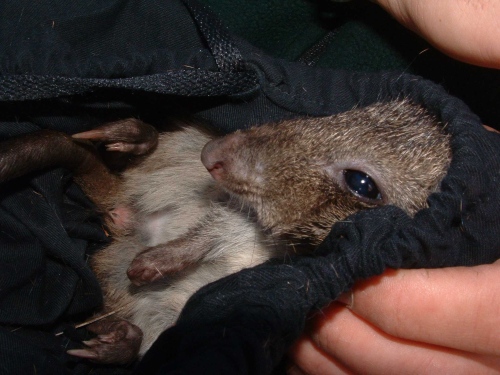
Juvenile Long-nosed Potoroo in care: Andrew Dennis, Parks Victoria, Halls Gap
References & Links
- Bennett, A.W. (1987) Biogeography and conservation of mammals in a fragmented forest environment in South-Western Victoria. A thesis for Doctor of Philosophy, Department of Zoology, University of Melbourne, July 1987. Also; Austral Ecology 14 (3), 375-376. DOI: 10.1111/j.1442-9993.1989.tb01446.x
- Claridge, A. W., Tanton, M. T., Seebeck, J. H., Cork, S. J. & Cunningham, R. B. (1992) Establishment of ectomycorrhizae on the roots of two species of Eucalyptus from fungal spores contained in the faeces of the long-nosed potoroo (Potorous tridactylus). Austral Ecology 17 (2), 207-217. doi: 10.1111/j.1442-9993.1992.tb00799.x
- Claridge, A.W., Cunningham, R.B., Tanton, M.T. (1993) Foraging patterns of the long-nosed potoroo (Potorous tridactylus) for hypogeal fungi in mixed-species and regrowth eucalypt forest stands in southeastern Australia, Forest Ecology and Management, 61 (1993) 75-90, Elsevier Science Publishers B.V., Amsterdam
- Claridge, A.W., Tanton, M. T., Cunningham, R.B. (1993) Hypogeal Fungi in the Diet of the Long-nosed Potoroo (Potorous tridactylus) in Mixed-species and Regrowth Eucalypt Forest Stands in South-eastern Australia. Wildlife.Research., 1993a, 20 (3) 321-37
- Claridge, A.W. and Cork, S.J.(1994) Nutritional-Value of Hypogeal Fungal Sporocarps for the Long-Nosed Potoroo (Potorous-Tridactylus), a Forest-Dwelling Mycophagous Marsupial Australian Journal of Zoology 42(6) 701 - 710
- Claridge, A.W. and Barry, S.C.(2000) Factors influencing the distribution of medium-sized ground-dwelling mammals in southeastern mainland Australia. Australian Journal of Ecology 25 (6), 676-688. doi: 10.1046/j.1442-9993.2000.01068.x
- DELWP (2020) Provisional re-assessments of taxa as part of the Conservation Status Assessment Project – Victoria 2020, Department of Environment Land Water and Planning, Victoria. Conservation Status Assessment Project – Victoria
- DSE (2013) Advisory list of threatened vertebrate faunain Victoria 2013, Department of Sustainability & Environment (Department of Environment, Land, Water & Planning 2016)
- Frankham, G., Reed, R., Fletcher, T., & Handasyde, K. (2011) Population ecology of the long-nosed potoroo (Potorous tridactylus) on French Island, Victoria, Australian Mammalogy 33(1) 73-81 CSIRO Publishing.
- FFG Threatened List (2025) Flora and Fauna Guarantee Act 1988 - Threatened List - September 2025 Department of Energy, Environment and Climate Action (DEECA) Victoria.
- Frankham, G., Handasyde, K., & Eldridge, M., (2012) Novel insights into the phylogenetic relationships of the endangered marsupial genus Potorous, Molecular Phylogenetics and Evolution 64(3):592-602 · May 2012 Researchgate DOI: 10.1016/j.ympev.2012.05.013
- Kirstin, I. L. (2001) Spatio-temporal interactions among male and female long-nosed potoroos, Potorous tridactylus (Marsupialia : Macropodoidea): mating system implications Australian Journal of Zoology 49(1) 17 – 26 CSIRO publishing doi: 10.1071/ZO00077
- Lupone, L., Ralph, A., Barker,J., Cooke, R., Rendall, & White,J. (2025) Finding a needle in a heath stack: A strategy to optimize the detection of a rare marsupial on the brink of local extinction - Biological Conservation, Volume 313, January 2026, 111524 - ScienceDirect, 6 October 2025
- Martin, By Greg (2003) The role of small ground-foraging mammals in topsoil health and biodiversity: Implications to management and restoration. Ecological Management & Restoration 4 (2), 114-119. Wiley Online doi.10.1046/j.1442-8903.2003.00145.x
- Robley, A., Gormley A., Albert, R., Bowd, M., Hatfield, C., McDonald, R., Scroggie, M., Smith, A., Thorp, A., and Warton, F. (2012) Glenelg Ark 2005–2011: Evidence of Sustained Control of Foxes and Benefits for Native Mammals. Arthur Rylah Institute for Environmental Research Technical Report Series No. 240.pdf Department of Sustainability and Environment, Heidelberg, Victoria.
- Seebeck, J.H. (1995) Family Potoroidae x 5 sp., In; Mammals of Victoria, (Ed). Menkhorst, P.W., Oxford University Press, South Melbourne, Australia.
- Species Profile and Threats Database, Long-nosed Potoroo, Australian Government, Department of Environment & Energy
- Tory, M. K., May, T. W., Keane, P. J. & Bennett, A. F. (1997) Mycophagy in small mammals: A comparison of the occurrence and diversity of hypogeal fungi in the diet of the long-nosed potoroo Potorous tridactylus and the bush rat Rattus fuscipes from southwestern Victoria, Australia. Austral Ecology 22 (4), 460-470. Wiley Online 10.1111/j.1442-9993.1997.tb00697.x
- VBA (2024) Victorian Biodiversity Atlas, Department of Environment, Land, Water & Planing, Victoria.
- VVB (2024) Visualising Victoria's Biodiversity.
- White, J. (2025) pers. comms. School of Life & Environmental Sciences, Deakin University, Geelong, Australia.


